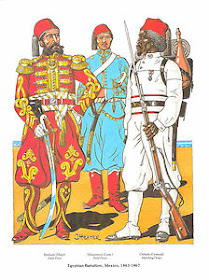
The caption on the illustration of military uniforms above, left, though it may be difficult to read, says "Egyptian Battalion in Mexico 1863-1867." This has to be one of the more curious expeditions in the history of European colonialism.
The strange French adventure in Mexico during the American Civil War, in which Louis Napoleon installed a Hapsburg Prince, Maximilian, as Emperor of Mexico, is a strange interlude, one that ended badly for Maximilian (in the firing squad sense of "badly"). Benito Juarez and Mexican Revolutionaries on the one hand, and the United States on the other (which, once the Civil War ended, decided to enforce the Monroe Doctrine and get rid of a European Emperor in Mexico) spelled the end of the strange adventure. But if a Hapsburg Emperor of Mexico installed by a Bonaparte wasn't strange enough, part of Maximilian's Army was a battalion of Egyptian troops (mostly Sudanese enlisted men with Egyptian officers), the bright idea of someone who thought Sudanese troops would be more easily acclimated to the Mexican heat than Frenchmen.
 |
| Said Pasha, Wali of Egypt 1854-1863 |
The Egyptian Wali Said Pasha agreed to provide an "Auxiliary Battalion" of 447 men in four companies. They sailed from Alexandria on January 9, 1863, aboard the troopship
Seine. Said Pasha died nine days later, succeeded as Wali by his nephew Ismail. (The title Khedive, though in popular use, was not officially recognized by the Ottoman Sultan until 1867.)
 |
| Arrival in Veracruz |
The expedition suffered severely from disease en route: a typhus outbreak aboard ship, a yellow fever outbreak after arrival in Veracruz, that killed the commanding officer, and other bouts with dysentery and pulmonary diseases. The force did see action against the
Juaristas, and their French commander is said to have remarked that they fought like lions. The French used some Algerian troops as translators.
 |
| The Egyptian Battalion Arrives in Paris |
In 1867, the 326 survivors of the Egyptian battalion sailed from Mexico after the fall of Maximilian. Louis Napoleon reviewed them in Paris before their return to Egypt. Accounts of the Egyptian battalion
here and
here; a
contemporary New York Times report here.
 The caption on the illustration of military uniforms above, left, though it may be difficult to read, says "Egyptian Battalion in Mexico 1863-1867." This has to be one of the more curious expeditions in the history of European colonialism.
The caption on the illustration of military uniforms above, left, though it may be difficult to read, says "Egyptian Battalion in Mexico 1863-1867." This has to be one of the more curious expeditions in the history of European colonialism.



The French also brought along with them Haussmann's Paris street design and French style cooking, both are still evident in present day Mexico City
ReplyDelete